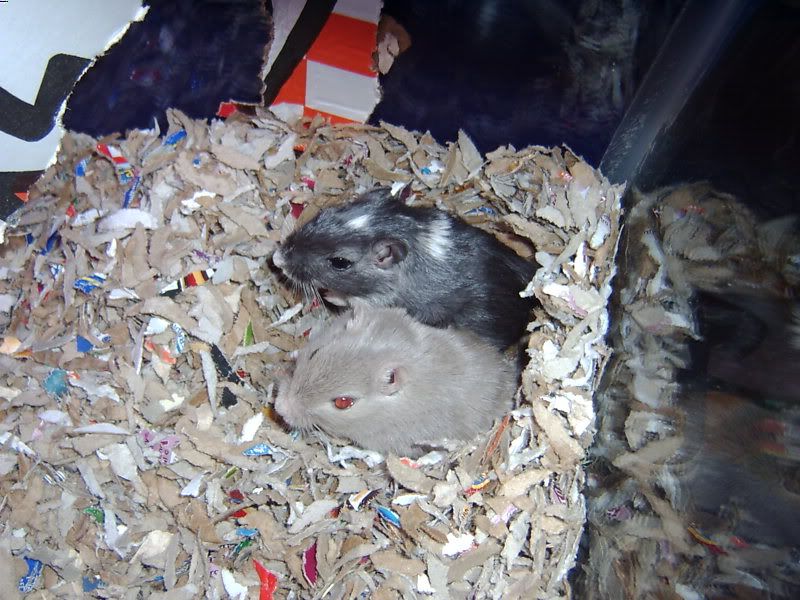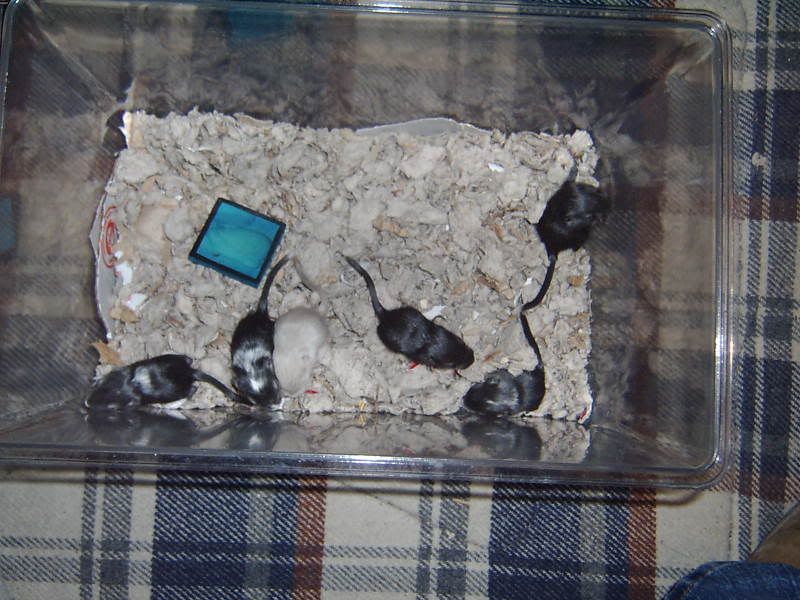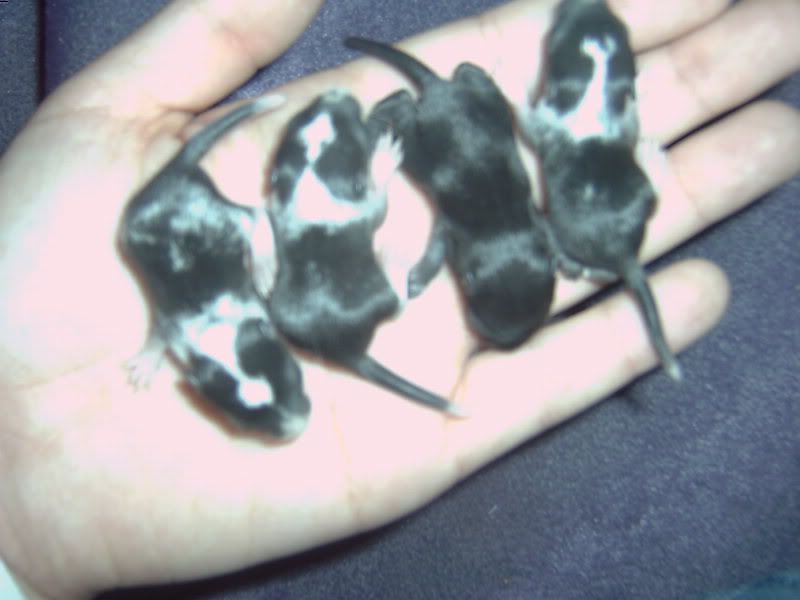|
|
Post by jyrenze on Aug 22, 2006 23:47:41 GMT -8
I would like to breed some red eyed pieds, like pied argente,dove or lilac. Right now I have 1 pied agouti with Pp and her daugther, also pied agouti with Pp. The mother only gave me 1 pied in her litter of 4, the rest were non spotted. I heard that breeding a spotted gerbil to another will result in 2/3 of the offspring being spotted. However does it matter if one of the pair shows very little spotting? I dont want lightly spotted offspring, but pied ones. Now my current litter is from 1 pied agouti x 1 self lilac Pups = 1 argente, 1 lilac, 1 pied agouti, 1 agouti.  mum  baby If I want to get more pieds from her is it a must to breed her to another pied? Or will spotted be alright? |
|
|
|
Post by Shanawaz on Aug 23, 2006 2:27:18 GMT -8
Hi,
Just wanted to share my thoughts and experience on this topic.
I mated a Pied Black(Plio,RIP) with a Spotted Agouti last year. The mating resulted in 2 pups being Spotted, like the Agouti, and a Pied/Mottled. Mating 2 Spsp gerbils would usually increase the spotting of the pups.
In your case, its the same. You should be able to get pieds from your gerbils. If you want to increase the no. of pieds in the litters, you could pair them to a pied. But you will still get pieds if paired with a Spotted because there's a parent which is a Pied. If you want to increase your chances, you could breed the females to a Pied or a Spotted gerbil related to a Pied. Maybe a Spotted with a Pied mother or sibling.
Good Luck
|
|
|
|
Post by RitzieAnn on Aug 24, 2006 8:19:31 GMT -8
Pied's ar a headache.... so have fun- and be patient. You may be breeding for quite some time before you get some that you really like. Funnny too is because you don't always need to use 2 spotted/pied/mottled gergbils. Acutally- I think Sandy got her Milky Way out of a spotted and a self lilac. I think. And Ritzie was very lightly spotted, and bred 3 times with 2 different males- solid color, one Siamese one Lilac.... and most of her pups were spotted- SparkyII was even lightly mottled.  3 marked pups in the 2nd litter,  and 4 out of the 6 in the first litter were spotted or pied (sorry, no picture of that litter) And then with the lilac I got my only mottled. Sorry, this is after he was nearly killed, and I've not gotten any better pic yet, but you can still see all his white.  Here's his entire litter.  So, Like I said, have fun, and be patient. I never knew that I would get so much white on the pups because Ritzie was so lightly spotted. It was suprise for me! |
|
|
|
Post by jyrenze on Aug 29, 2006 19:16:34 GMT -8
Nice gerbils you have there  . lol, I know that pieds can come out of lightly spotted gerbils, but I'm wondering if lightly spotted gerbils can come out of a pied x pied pair? If I pair up 2 pieds can I maintain a pied line? |
|
|
|
Post by leopaixao on Aug 29, 2006 20:18:16 GMT -8
I don't know what you are thinking, but breading two gerbils with the gene Sp will get 1/4 os the litter dead before even beig born. The gene in question is a lethal gene, and dominant homozygote will cause the pup’s death. So, you will get 2/3 spotteds, instead of 3/4 as you may think. If u like the pattern of your pied, let your couple keep breading that without doubt some argentes, lilacs or doves pieds will be born. Be patient. There is no way you can increase the spots by mating two spotteds, only the heterozygotes will be spotted.
|
|
|
|
Post by RitzieAnn on Aug 29, 2006 20:56:07 GMT -8
This is ture about SpSp pups not existing. But it isn't as bad as leopaixao made it sound. When the sperm and egg meet, the embreo desolves before it even latches on to the uterus. It's not even a "pup" yet- at this point it's only a few cells- no heart or anything- so don't be afraid that you're "killing" a bunch of pups by breeding an Spsp to another Spsp. But, yes, it would be only 2/3. Nice point leo!
|
|
|
|
Post by doomgerbiluk on Aug 29, 2006 23:08:35 GMT -8
In fact even that is innacurate.
Gerbils produce a large (by our standard) of embryos. Only some of these will implant. Since there are redundant embryos what happens is that embryos which are not viable (ie SpSp embryos, which are prenatally fatal) are absorbed before implantation and healthy embryos are implanted. My largest Sp x Sp litter was 11 pups (sadly two stillborn)!!!
Also there is at present no recessive on the Sp loci therefore there is no sp gene, therefore gerbils cannot be spsp or Spsp, they are either Sp or not.
Why does this matter? Because if a recessive does appear on the Sp loci then it will be labelled sp.
Hope this helps and reassures.
|
|
|
|
Post by leopaixao on Aug 30, 2006 16:12:32 GMT -8
It's not Sp loci, it's locus. Loci is the plural of locus.
And of course that there is a recessive. If a characteristic is expressed by the presence of a gene, it is dominant, and there is a criteria of dominance over the non-characteristic. You know, over the Sp fragment of DNA there is a mutation, but where there wasn't, in the sp, still, there is a fragment of DNA with some nitrogen bases switched. I know there is a rule to nominate the gene with the recessive initial, but ok, in spots we consider spotted Sp and non spotted nothing, because it’s non spotted.
About the number of gametes in each gerbil cycle, I never red something about it. If you could give me the reference from where you red it, i would appreciate. What I thought was that each and every one of them fecundated, but the SpSp, were implanted.
But in one thing we agree, mating spotted gerbils with pied one will not make mottled, only spotteds and pieds, unless a mottled comes from the pied, but there even breading a pied with a non spotted would do the same.
About the 2/3 I thought I was right. In genetics things are mathematical. My explanations for your 11 pups SpSp litter is this: probably, as it is a very random thing, there was a very small number on SpSp embryos in this litter, and was a very big litter. Luck, just luck, one litter isn’t statistically significant to prove anything.
I think that’s it. Ok, sorry about my English, I’m from Brazil.
|
|
|
|
Post by Shooting Star on Aug 30, 2006 19:15:24 GMT -8
Just a few points to Leo: A) I wouldn't be so hasty to correct someone's English if you're not a native speaker, and feel the need to apologize for your own. Yes, you were correct that the singular form is 'locus', and I didn't notice any outstanding errors in your own post, it just came across a bit curt.  B) Yes, technically, there would be a gene recessive to Sp. However, since the mutation at that locus is the dominant form, the wild-type is designated '+', not 'sp'. So, a spotted is Sp+ and a wild-type is ++. I believe the same is true for the very similar dominant, homozygous-lethal, white-spotting gene in mice, W. C) I am only aware of one published study in spotting with gerbils (in English): the first "report" of spotting, in the 1978 Journal of Heredity. It is noted that SpSp offspring "presumably die shortly before birth", and the numbers given indicate that Sp+/++ pairs produced nearly twice as many viable pups as Sp+/Sp+ pairs. However, there do not seem to be any follow-up experiments, done by other scientists. Even in light of the sheer numbers involved in the study, it may not be wise to accept this data as an accurate representation of what will happen, without cross-checking and replication by other groups. As I have not worked with spotting in my lines until very recently, I can not personally "prove" that this prediction is inaccurate. I do know, though, that I have had three litters of six and one litter of two in the past two months. One litter of six born to a ++/++ pair, one litter of six born to a Sp+/++ pair, and the other litter of six and the litter of two born to a different Sp+/++ pair. My Sp+/Sp+ pair will be having pups in a week or two, so I will be sure to compare numbers then.  |
|
|
|
Post by doomgerbiluk on Aug 31, 2006 0:09:48 GMT -8
First in scientific terms you are correct, in breeding, laymens terms we talk about the genes or loci we get a visible effect from in the phenotype. In non-Sp gerbils there is no difference, not having spots is no different from before the Sp mutation occured, or you could say that as breeders it is mutations we are talking about rather than genes or loci. so we do not use sp because no recessive mutation has appeared. As for the numbers of pups in SpxSp litters, I have bred, over 3 years, many, many SpxSp litters and on average they are larger. Not only that but within National Gerbil Society discussions it has become apparent that non of the breeders have experienced a drop in the number of pups in SpxSp litters. If the pups died just before birth as you indicated you would expect almost every SpxSp litter to have stillborn pups, and I have personally only witnessed stillbirths the once, I have heard of one other litter which also had stillborn pups, and the mother was a daughter of my mother who had stillbirths, again it was a large litter. While I have not read papers on the subject, I have discussed this matter extensively with Eddie who runs E-gerbil at www.gerbilshowsuk.org and I'm sure either he or Julian Barker (NGS president, http://www.gerbils.co.uk)) will be able to point you to the necessary literature. For the laymen here you are quite safe to breed SpxSp litters, the fact that the SpSp pups do not develop will not reduce your overall litter size and as long as you breed from healthy parents there should be no greater risk than to any other litter. |
|
|
|
Post by leopaixao on Aug 31, 2006 8:17:21 GMT -8
OK.
Shootingstar, “locus” and “loci” are not English words, they are Latin, and i learned them in my genetic lessons at the college i’ve been.
Doomgerbiluk, I don’t know much about ovulation and fecundation in animals, only in humans, because I’m a physician, that’s why I have this concepts. The paper I asked for is just for me to understand about rodent’s ovulation and nidation. This thing that you said about a lot of eggs but only a few were fixated in the uterus is very different and weird for me, because of my different knowledge.
But I think your arguments were good enough, and i believe you. I’ll start breading Sp + Sp + gerbils and see what happens.
Thanks, and sorry agains for any misunderstanding.
|
|
|
|
Post by jyrenze on Aug 31, 2006 8:27:59 GMT -8
Woah, I had to read all the posts a few times to make sure I did not miss out anything, very scientific stuff there, but anyway i was already aware that in theory sp x sp will produce less pups than sp x non spotted, because of the lethal gene but also aware that the SpSp fetus will not develop in the womb, so its not like breeding dwarf rabbits where a peanut with both resessive genes is born and most certainly will die later on. Sorry if my original question was not very clear but I am not aiming for 100% of sp pups, just to clarify that. I know that the most I can get is around 2/3 for a sp x sp pair, what I want for them is to be pied, and not spotted. I also know that I will get pied red eyed gerbils eventually with my current pairing but I would prefer to avoid that as you never know what might come out next, it could be yet another pied agouti or perhaps black, I prefer to limit my breeding as it is not good for the mother to have too many kids in her lifetime, moreover the lilac father is of dubious health and quality as he is adopted and has shown allergies to some types of wood shavings and certain other bedding, which occured only after the pups were born. I really hope he has not passed down the allergies to his pups, but anyway I hope not to breed him again. It would be most troublesome to the new owner if any pups I rehome have bedding allergies. So I figure the fastest way to get the pied gerbils that I want is to pair the mum or her daugther to another sp red eyed gerbil. So my real question, once again is whether pied x pied pairing has a higher chance of giving me pied gerbils compared to pied x spotted. Higher meaning that any pups born with sp will have pied markings, and not ligthtly spotted or with a partial collar, assuming that the pied parent/parents have great pied markings. Thanks for taking the time to answer my question  |
|
|
|
Post by sandy on Aug 31, 2006 10:20:40 GMT -8
Hi jyrenze, from my experience, breeding pieds together will give you pieds, a few light mottleds and non-spotteds. You should select pied parents that have no colour intruding in the collar, and have a good clean collar definition. You want to aim for right-left symmetry in the spotting pattern, too. And it goes without saying that you want large, healthy, well-shaped gerbils (you can look up gerbil show qualities at some of the gerbil show entrance requirements, such as the American Gerbil Society post online).
Also I can say from my own multiple-year breeding experience that spotting in parents seems to have no effect whatsoever on the number of pups in the litter. The largest litter (10) was from a spotted parent, as a matter of fact.
|
|
|
|
Post by RitzieAnn on Sept 2, 2006 9:19:55 GMT -8
 OY.... That was all a bunch of stuff to take in.... Ok, yeah- so back to you main question! LOL I agree with Sandy. I've only ever used one spotted gerbil for breeding, and that was Ritzie. She gave me MANY spotted pups, and even Sparky II (that mottled) But all 3 of her litters had 6 pups. The 3rd (Sparky II's litter, had 8 born, but my roomate touched them as pinkies, and Daddy gerbil freaked out.) But her litters were just as big as all my other litters!
|
|